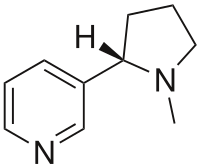
Photo from wikipedia
Niacin (also known as “vitamin B3” or “vitamin PP”) includes two vitamers (nicotinic acid and nicotinamide) giving rise to the coenzymatic forms nicotinamide adenine dinucleotide (NAD) and nicotinamide adenine dinucleotide… Click to show full abstract
Niacin (also known as “vitamin B3” or “vitamin PP”) includes two vitamers (nicotinic acid and nicotinamide) giving rise to the coenzymatic forms nicotinamide adenine dinucleotide (NAD) and nicotinamide adenine dinucleotide phosphate (NADP). The two coenzymes are required for oxidative reactions crucial for energy production, but they are also substrates for enzymes involved in non-redox signaling pathways, thus regulating biological functions, including gene expression, cell cycle progression, DNA repair and cell death. In the central nervous system, vitamin B3 has long been recognized as a key mediator of neuronal development and survival. Here, we will overview available literature data on the neuroprotective role of niacin and its derivatives, especially focusing especially on its involvement in neurodegenerative diseases (Alzheimer’s, Parkinson’s, and Huntington’s diseases), as well as in other neuropathological conditions (ischemic and traumatic injuries, headache and psychiatric disorders).
Journal Title: International Journal of Molecular Sciences
Year Published: 2019
Link to full text (if available)
Share on Social Media: Sign Up to like & get
recommendations!